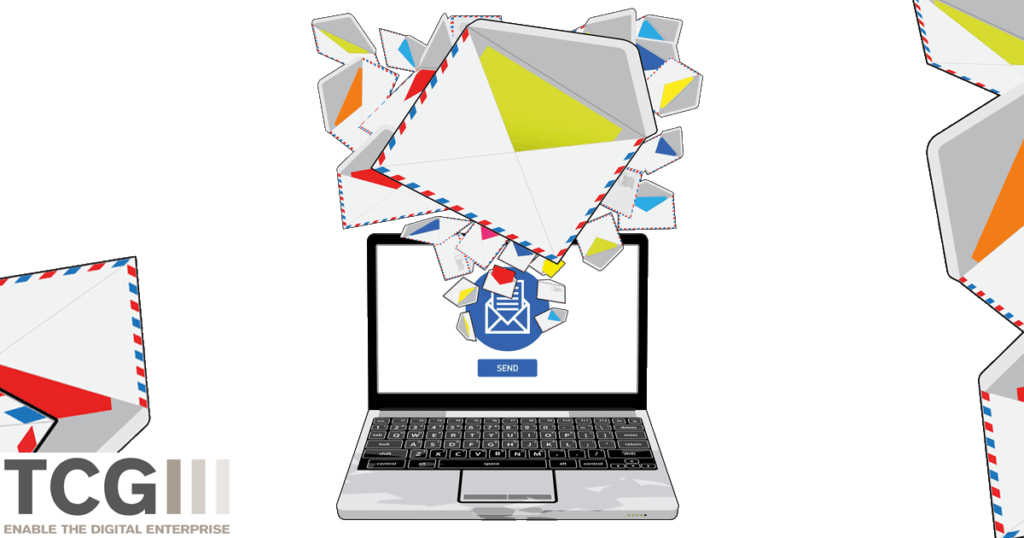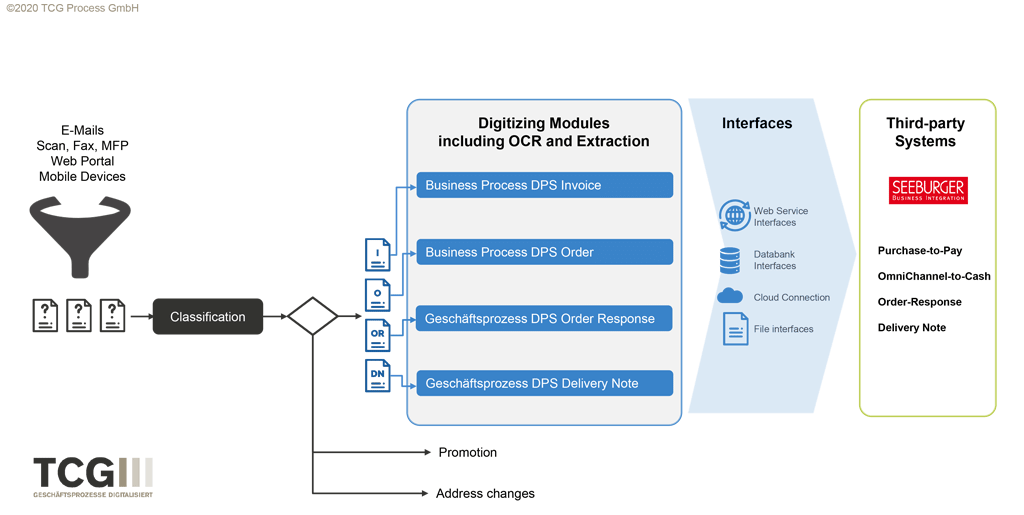
A heterogeneous inbox requires intelligent solutions to make the subsequent business processes transparent, efficient and cost-effective. In part two of her guest article, Sara Mazzorana of TCG Process GmbH, explains how artificial intelligence in digital incoming mail solutions ensures structured incoming mail with direct connections to further processes.
Incoming Mail – All In One Pot?
Companies like to use collective mailboxes for both letters and e-mail. Typical e-mail mailboxes are info@… or service@… – There are no limits to creativity. But if you think about your own correspondence, you will quickly realize where this will take you. Whether it’s an inquiry, order, cancellation of an order or a change of address – everything is sent to the generic e-mail address and ends up in the same mailbox. People sometimes wait for days for a response, get impatient and end up writing another e-mail to inquire about the status.
If you look at the situation from the recipient’s point of view, such a collective mailbox means an immense manual effort for sorting and distributing incoming mail. As a customer, we naturally have no understanding and certainly no patience for this. On the contrary. As digitization continues, we expect immediate processing and feedback on the current processing status. And rightly so, because it is possible to get to grips with even the most heterogeneous incoming mail.
Incoming mail solutions – adaptable to every individual requirement
Digital incoming mail solutions such as those from TCG Process GmbH automate the processing of all incoming mail from individual organizational units or the entire company.
A digital incoming mail solution is designed to meet the specific needs and requirements of the company. Depending on the system environment, core processes and input channels, special adaptations are required. Therefore there is usually no simple off-the-peg solution. A special competence of the providers lies in understanding the customer’s requirements and adapting the solution to the customer-specific situation.
These requirements play a special role in every incoming mail solution:
- The solution must be capable of multi-channel input. For the digital inbox, it does not matter whether documents are received in paper-based or electronic format. All documents are processed using a single process. Thanks to the corresponding interfaces, conversion steps and sub-processes, documents of all common input formats from all input channels, whether fax, scan, e-mail, web portal or mobile devices, can be processed on one platform in one solution. The system can also be flexibly expanded if additional input channels or new formats such as audio or video are added in the future.
- Intelligent document separation: Sometimes different document types are contained in one e-mail, e.g. an order and at the same time a signed outline agreement. These documents must be automatically separated and fed into the respective processing procedure. At the end of the process, they should be merged as required and transferred in their original format to the subsequent third-party system, such as SEEBURGER Solution Extensions for SAP, or the archive.The core of incoming mail solutions is the artificial intelligence contained in the classification: the classification enables the differentiation between different document types. There is technically no upper limit for the number of document types or classes. As long as the distinguishing features for classification are clear, the document is assigned to the correct class. Depending on the class, the document can then be assigned to the next processing step. The classification can be content-based (e.g. text) or layout-based (e.g. image).How do I achieve optimal results automatically?
By using artificial intelligence (AI) in classification.
At the beginning, the individual document classes are trained with sample documents. The AI learns the grouping and distinguishing characteristics of the document classes on the basis of the examples and is then able to make this distinction itself in productive operation. If the distinguishing features are very pronounced, just a few training documents are sufficient to enable automatic classification. Experience has shown that more documents must be used for training if the distinguishing features are weak. Modern systems automatically learn when documents are manually assigned in post-processing and thus enable continuous improvement. - User interaction takes place when it is necessary: without a digital inbox solution, the user is busy for hours sorting and processing incoming mail. With a digital incoming mail solution, manual processing is eliminated and interaction is reduced to a minimum. The user only intervenes when documents cannot be clearly assigned to a certain class. So if a certain threshold value is not reached, the document appears in DocProStar’s validation client. This type of validation client allows the user to view the document, select the correct class, route it further and add a message if necessary.
- Perfect interfaces and seamless integration: the digital data must be transferred to the appropriate third-party systems in the desired format. For this to succeed, the necessary interfaces must be available. It is precisely in this respect that the customer’s involvement is of great importance, so that all interfaces are recognized and the necessary preparations for seamless integration are made.
- Direct data processing in further processes: Isolated solutions are annoying and cause unnecessary additional work. Depending on the document type, the classified documents can be assigned to a specific follow-up process. These partially standardized solutions, for example for common commercial document types such as invoices, purchase orders, order confirmations and delivery bills, start the capture process directly after classification. For example, purchase orders are assigned to the process for order processing. Here, in turn, the processing steps OCR and extraction necessary there take place in order to pass on the data relevant for decision-making to the corresponding third-party system, e.g. the SEEBURGER OmniChannel-to-Cash solution. For the example of orders, the delivery process is started without delay.
 Figure 1: Digital data processing with DocProStar from TCG and specialized systems from SEEBURGER
Figure 1: Digital data processing with DocProStar from TCG and specialized systems from SEEBURGERWhy is digital processing of incoming mail relevant for your company?
- The flow of documents within the company is accelerated immensely. Instead of the time-consuming manual sorting and forwarding of relevant information by an employee, an incoming mail solution such as TCG’s uses artificial intelligence to do the job.
The process does not differentiate between incoming channels. All incoming documents are treated equally and end up in the right place. - Processing and reaction times are significantly reduced. Your customers will receive faster and dependable feedback on their request. Automatically generated (Auto Response) feedback can also be sent via the process, so your customer is always well informed. Customer satisfaction is increased.
- You have an overview of all data that enters and is processed in your company (regardless of the input format). This way you increase transparency and maintain control and security of your incoming mail across all input channels.
- The initial investment will pay for itself over time, as you save on the operating costs of manually sorting, organizing and tagging documents while implementing the process. Your employees gain in productivity and can dedicate themselves to decision-relevant activities.
- Subsequent third-party systems receive the necessary information more quickly to initiate further transactions, such as delivery after receipt of the order.
TCG Process GmbH offers technologically pioneering solutions in the field of input management and business process automation (BPA). We support our customers along the entire implementation process.
With DPS Digital Mailroom you have a solution with a highly scalable and multi-client capable platform. Different processes and high volumes of documents can be processed in one process on one platform. The solution is suitable for use on-premises as well as in the cloud and can be extended by the SEEBURGER Solution Extensions for SAP.
- Purchase-to-Pay
- OmniChannel-to-Cash
- Order-Response
- Delivery Note
Please contact us for further information: Marcus.kern@tcgprocess.com
Do not hesitate to ask for our user reports directly, so you can get an insight into the solutions used by our customers.
Source: https://blog.seeburger.com/using-ai-for-digitizing-incoming-mail/
 sap-combine.com
sap-combine.com
